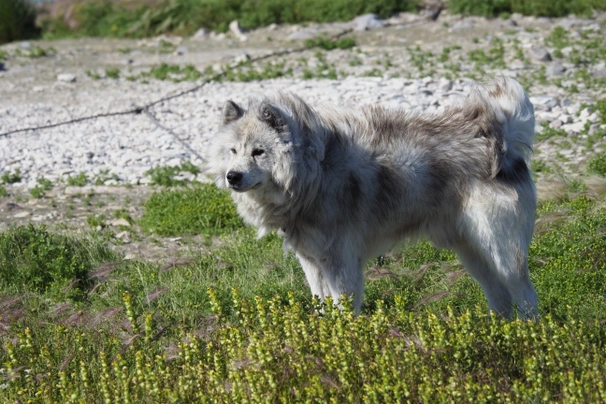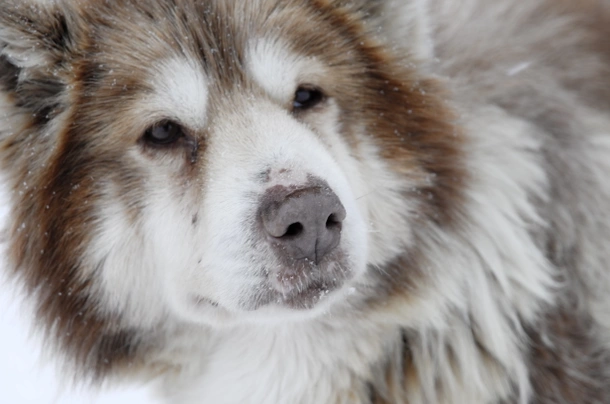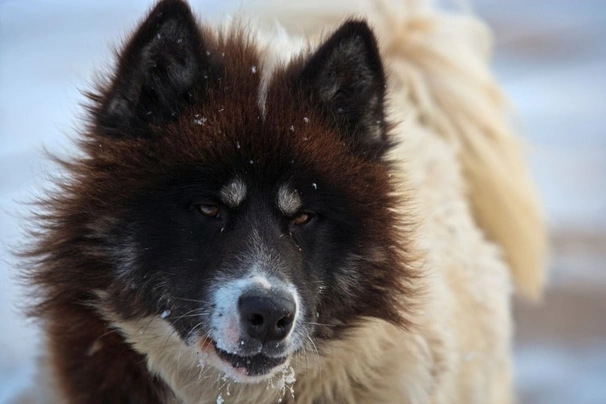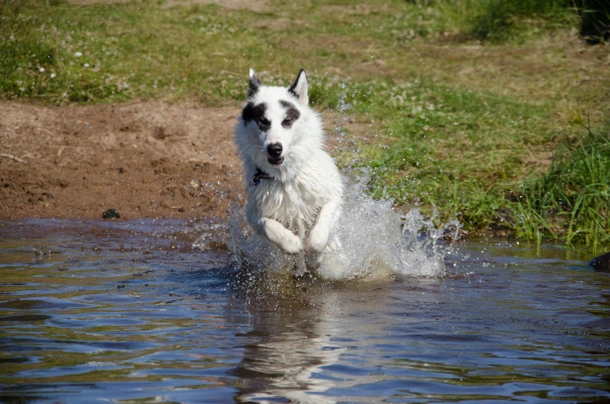Canadian Eskimo Dog
Introduction of the Canadian Eskimo Dog
The Canadian Eskimo Dog looks very much like a Husky being a Spitz-type breed that hails from the Arctic regions of the world. These handsome dogs are recognised by The Kennel Club and over the years although their numbers still remain low here in the UK they are becoming a popular choice with people who are familiar with the breed and who enjoy competing with dog teams. Often called Qimmiqs the Canadian Eskimo Dog boasts a lot of stamina having been bred to pull sleds over vast distances in challenging conditions and arctic terrains. They are true working dogs rather than pets and are highly prized in Greenland where a renewed interest in cultural heritage saved the breed from extinction.
History of the Canadian Eskimo Dog
It's thought the Canadian Eskimo Dog has been around for thousand years and that they have always worked alongside the Inuits or Eskimo people. They were bred as working dogs and never as pets or companions. Their job was to pull sleds and to help their masters hunt quarry in often challenging conditions and sub-zero temperatures.
These handsome spitz-type dogs have also helped intrepid explorers on their expeditions to both the North and South Poles. Right up until the early nineties the Canadian Eskimo Dog was used by the Australians at their Antarctic station. Back in the twenties there were around 20000 Qimmiqs in northern Canada but with the advent of snowmobiles and their ever increasing popularity breed numbers fell into decline and by the seventies there were less than 200 dogs left in the country.
Fortunately through the efforts and determination of William Carpenter who together with the Canadian Kennel Club saved these handsome working dogs from extinction when a breeding programme was set up using dogs true to the breed. The Qimmiq is also making a comeback in Greenland where a renewed interest in Inuit cultural heritage has seen more dogs being kept in their natural environment doing what they have always been bred to do which is to work alongside man.
Although the Canadian Eskimo Dog gained recognition in the UK in 2000 their numbers remain low and anyone wishing to share their homes with one of these handsome dogs would need to register their interest with breeders for the pleasure of doing so bearing in mind that Qimmiqs are first and foremost working dogs and not really family pets or companions.
Appearance of the Canadian Eskimo Dog
Height at the withers: Males 58 - 70 cm Females 50 - 60 cm
Average weight: Males 30 - 40 kg Females 18 - 30 kg
The Canadian Eskimo Dog is a typical spitz-type looking breed and are similar to Huskies in that they have a powerful and proud appearance. They are dogs that are built to work over challenging terrains and in harsh arctic conditions as such their coats offer them a tremendous amount of protection against the elements. They have well-proportioned large heads that are wedge shaped and broad. Muzzles taper to the nose and are moderately long with male dogs having broader skulls than their female counterparts. Their eyes are round in shaped and placed wide apart and rather obliquely on a dog's face. Eyes are usually a dark colour although hazel and yellow eyes are acceptable under their breed standard but never blue.
Their ears are triangular in shape being thick and short with rounded tips and well covered in thick short hair both on the inside and the outside of the ears. Dogs carry their ears erect and always facing to the front. The Canadian Eskimo Dog has a strong jaw with a perfect scissor bite where their upper teeth neatly overlap their lower ones. Their necks are straight short and thick being extremely well muscled. Shoulders are broad and nicely laid back being well muscled and a dog's front legs are well-developed and straight with some dogs having dewclaws whereas others do not.
The Canadian Eskimo Dog has a powerful looking body with a well-developed wide and deep chest. Their ribs are moderately well-sprung and their loins nicely developed. Backs are level and well-muscled with dogs only having a slight tuck up to their bellies. Their hindquarters are strong with well-muscled back legs. Feet are well arched and virtually round in shape with thick hair growing between a dog's pads and toes. Tails are bushy and large being set moderately high and which dogs carry high or over their backs. Mature female Qimmiqs often carry their tails down.
When it comes to their coat the Canadian Eskimo Dog boasts having a thick and very dense undercoat with stiff hard guard hairs. Males have more hair around their necks which forms a mane whereas a female's coat is that much shorter all over the body. The accepted breed colours are as follows:
- Black and white
- Grey and white
- Grey sable
- Red and white
- Sable and white
- White
- White and black
- White and grey
- White and red
Temperament of the Canadian Eskimo Dog
The Canadian Eskimo Dog is very workmanlike in their approach to life having been bred to work alongside man for centuries in some of the most challenging conditions and terrains in the world. Their need to work is deeply embedded in their psyche which is something that potential owners need to fully appreciate before taking on one of these handsome dogs. They were bred to hunt too which means they boast having a high prey drive. Young dogs tend to be boisterous and strong willed but as they mature they mellow out becoming more affectionate enjoying the attention owners give them.
Qimmiqs are extremely "pack oriented" by nature and as such they do not do that well when kept as a solitary pet much preferring the company of other dogs in their environment. They are also extremely alert being aware of everything that goes on around them. They are not the best choice for first time owners because these dogs need to be handled and trained by people who are familiar with their very specific needs. They are true working dogs and enjoy nothing more than to be pulling a sled or rig and hunting alongside their owners. With this said anyone who enjoys competing with a dog team would not go far wrong by choosing Canadian Eskimo Dogs.
It's really important for these dogs to be well socialised from a young age. Their socialisation has to include introducing them to lots of new situations noises people and dogs once they have been fully vaccinated. It's also crucial for their training to start early too and it has to be consistent throughout a dog's life so they understand what is expected of them. A Canadian Eskimo Dog is never happier than when they know their place in the pack and who they can look to for direction and guidance. If they don't know who is the alpha dog in a household they may quickly take on the role of a dominant dog which can make them harder to live with and handle.
They are known to like the sound of their own voices and will take to howling when the mood takes them which can prove to be a problem with neighbours. They like to establish a hierarchy within a pack and as such when kept with other Qimmiqs or dogs they will fight in order to establish a hierarchy which in short means care has to be taken when dogs are together in an environment.
Although Canadian Eskimo Dogs form strong ties with their owners but they are independent dogs by nature. They can be a little wary and aloof around strangers but rarely would one of these dogs show any sort of aggressive behaviour towards a person they did not already know preferring to keep their distance. Qimmiqs do not do very well in hot weather and can easily overheat if care is not taken as to when they are exercised.
Intelligence / Trainability of the Canadian Eskimo Dog
The Canadian Eskimo Dog is a smart dog and a fast learner. The downside to this is they are just as quick to pick up lots of bad habits as they are the good. They need to be well socialised from a young age and their training has to begin early too. It also has to be very consistent and always fair throughout a dog’s life so they understand what their owner expects of them. They are a good choice for people who want to take part in sledding-type competitions and other pulling activities because these dogs like nothing more than to work.
They excel at many canine sports which includes activities like dry land mushing because they thrive on the attention they are given during their training and the one-to-one contact when they are competing with their handlers. The key to successfully training a Qimmiq is to make their training as interesting as possible and to avoid too much repetition. It's also a good idea to keep training sessions that much shorter which helps dogs stay more focussed on what it’s being asked of them bearing in mind that the more intelligent a dog is the faster they get bored and Qimmiqs are extremely smart.
They do not answer well to harsh correction or any sort of heavy handed training methods but they do respond extremely well to positive reinforcement which always brings the best out of these intelligent and quick witted dogs especially when there are high value rewards involved bearing in mind that Qimmiqs find it hard to digest anything that contains grains.
Children and other
The Canadian Eskimo Dog is not the best choice as a family pet because these dogs thrive on being in a work environment rather than in a home. As such they are not a suitable choice for families with children either and care has to be taken when they are around other pets and animals because they boast such a high prey drive. As such any contact is best avoided.
They can be a little "off" with other dogs which is why it's so important for a Canadian Eskimo Dog to be well socialised from a young age and even then they have a tendency to want to dominate other dogs they encounter or live with in a household because Qimmiqs like to establish a hierarchy which often leads to fights breaking out.
Health of the Canadian Eskimo Dog
The average life expectancy of a Canadian Eskimo Dog is between 10 and 15 years when properly cared for and fed an appropriate good quality diet to suit their ages.
The Canadian Eskimo Dog is known to be a robust and healthy dog and one that does not seem to be affected by hereditary and congenital health disorders that can often affect other breeds. However their numbers are very long and with only a small gene pool to draw from care has to be taken in breeding programmes to ensure this handsome hard-working breed remains healthy and strong.
Caring for the Canadian Eskimo Dog
As with any other breed Qimmiqs need to be groomed on a regular basis to make sure their coats and skin are kept in top condition. They also need to be given regular daily exercise to ensure they remain fit and healthy. On top of this dogs need to be fed good quality food that meets all their nutritional needs throughout their lives.
Grooming of the Canadian Eskimo Dog
The Canadian Eskimo Dog boasts having a dense double coat with the outer coat being harsh whereas the undercoat is soft and downy to the touch. Their coats offer them tremendous protection against harsh cold weather conditions and although thick and dense they are pretty low maintenance on the grooming front only needing to be brushed once or twice a week to keep things tidy and in good condition.
They shed throughout the year only a lot more so during the Spring and then again in the Autumn when more frequent grooming is usually necessary to stay on top of things and to remove dead and shed hair from a dog's coat. It's also important to check a dog's ears on a regular basis and to clean them when necessary. If too much wax is allowed to build up it can lead to a painful infection which can be hard to clear up. In short prevention is often easier than cure with ear infections.
Exercise of the Canadian Eskimo Dog
The Canadian Eskimo Dog is smart and they like to be kept active which means they need the right amount of daily exercise and mental stimulation for them to be truly happy well-rounded dogs. They need anything from 40 to 60-minutes exercise a day with as much off the lead time as possible but only in very secure and safe environments away from other dogs and animals. If they are not given the right amount of mental stimulation and exercise every day a Qimmiq would quickly get bored and as a consequence they would develop some destructive behaviours which is their way of relieving any stress they are feeling and not necessarily because they are being naughty.
It's best to avoid walking an Eskimo Dog when the temperature is very warm because they don’t do well in hotter weather and can quickly overheat. The best time to exercise them is earlier in the morning and later in the afternoon when the sun is lower in the sky and therefore the temperature is that much cooler.
These dogs thrive on working and pulling sleds or rigs. As such anyone wishing to share their home with a Qimmiq would need to enjoy taking part in competitions and rallies with their dogs. With this said puppies should not be over exercised because their joints and bones are still growing. This includes not letting a dog jump up and down from furniture or going up or down the stairs. Too much pressure placed on their joints and spines at an early age could result in a dog developing serious problems later in their lives.
Feeding of the Canadian Eskimo Dog
If you get a Canadian Eskimo puppy from a breeder they would give you a feeding schedule and it's important to stick to the same routine feeding the same puppy food to avoid any tummy upsets. You can change a puppy's diet but this needs to be done very gradually always making sure they don't develop any digestive upsets and if they do it's best to put them back on their original diet and to discuss things with the vet before attempting to change it again.
Older dogs are not known to be fussy eaters but this does not mean they can be given a lower quality diet. Eskimo dogs need a high-protein diet whether they are working or not and it’s worth noting they have trouble digesting any sort of grain which in short means avoiding any sort of dog food containing "fillers". It's best to feed a mature dog twice a day once in the morning and then again in the evening making sure it's good quality food that meets all their nutritional requirements. It's also important that dogs be given the right amount of exercise so they burn off any excess calories or they might gain too much weight which can lead to all sorts of health issues. Obesity can shorten a dog's life by several years so it's important to keep an eye on their waistline from the word go.
Canadian Eskimo Dog price
If you are looking to buy a Canadian Eskimo Dog you would need to register your interest with breeders and agree to being put on a waiting list because very few puppies are bred and registered with The Kennel Club every year. You would need to pay anything upwards of £600 for a well-bred pedigree puppy.
The cost of insuring a male 3-year-old Canadian Eskimo Dog in northern England would be £19.49 a month for basic cover but for a lifetime policy this would set you back £45.91 a month (quote as of August 2016). When insurance companies calculate a pet's premium they factor in several things which includes where you live in the UK a dog's age and whether or not they have been neutered or spayed among other things.
When it comes to food costs you need to buy the best quality food whether wet or dry making sure it suits the different stages of a dog’s life. This would set you back between £40 - £50 a month. On top of all of this you need to factor in veterinary costs if you want to share your home with a Qimmiq and this includes their initial vaccinations their annual boosters the cost of neutering or spaying a dog when the time is right and their yearly health checks all of which quickly adds up to over £1000 a year.
As a rough guide the average cost to keep and care for a Canadian Eskimo Dog would be between £70 to £110 a month depending on the level of insurance cover you opt to buy for your dog but this does not include the initial cost of buying a well-bred puppy.



